| Listing 1 - 10 of 73 | << page >> |
Sort by
|
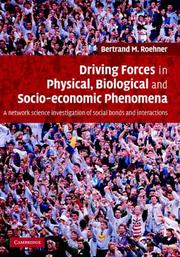
ISBN: 9781107411319 9780521859103 1107411319 0521859107 1107411319 9780511611148 9780511286742 0511286740 0511286023 9780511286025 0511284446 9780511284441 0511285264 9780511285264 0511611145 1280909927 9781280909924 1107177472 9781107177475 9786610909926 661090992X 0511322291 9780511322297 Year: 2007 Publisher: Cambridge Cambridge University Press
Abstract | Keywords | Export | Availability | Bookmark
 Loading...
Loading...Choose an application
- Reference Manager
- EndNote
- RefWorks (Direct export to RefWorks)
This book was first published in 2007. In recent years network science has become a dynamic and promising discipline; here it is extended to explore social and historical phenomena. While we experience social interactions every day, there is little quantitative knowledge on them. Instead we are often tempted to resort to fanciful explanations to explain social trends. Exogenous and endogenous interactions are often the key to understanding social phenomena and unravelling historical mysteries. This book begins by explaining how it is possible to bridge the gap between physics and sociology by exploring how network theory can apply to both. It then examines the macro- and micro-interactions in societies. The chapters are largely self-contained, allowing readers easily to access and understand the sections of most interest. This multi-disciplinary book will be fascinating to all physicists who have an interest in the human sciences and it will provide an alternative perspective to graduate students and researchers in sociology and econophysics.
System theory. --- Science --- Social networks. --- Suicide --- Théorie des systèmes --- Sciences --- Réseaux sociaux --- Philosophy. --- Social aspects. --- Philosophie --- Théorie des systèmes --- Réseaux sociaux --- Killing oneself --- Self-killing --- Death --- Right to die --- Networking, Social --- Networks, Social --- Social networking --- Social support systems --- Support systems, Social --- Interpersonal relations --- Cliques (Sociology) --- Microblogs --- Normal science --- Philosophy of science --- Systems, Theory of --- Systems science --- Causes --- Philosophy
Book
ISBN: 158603748X 6610934908 9786610934904 1429492309 160750247X 6000003358 1280934905 1433708604 9781429492300 9781607502470 9781586037482 9781586037482 Year: 2007 Publisher: Amsterdam Washington, DC IOS Press
Abstract | Keywords | Export | Availability | Bookmark
 Loading...
Loading...Choose an application
- Reference Manager
- EndNote
- RefWorks (Direct export to RefWorks)
Edited as a Festschrift in honor of Prof Milan Zeleny, this volume reflects and emulates his unmistakable legacy: the essential multidimensionality of human and social affairs. It contains papers dealing with: Multiple Criteria Decision Making; Social and Human System Management; and Information, Knowledge and Wisdom Management.
Multiple criteria decision making. --- Multiple criteria decision making --- System theory --- Civil & Environmental Engineering --- Engineering & Applied Sciences --- Operations Research --- System theory. --- Systems, Theory of --- Systems science --- Decision making with multiple objectives --- MCDM (Decision making) --- Multiattribute decisions --- Multicriteria decision analysis --- Multicriteria decision making --- Multicriteria decision making analysis --- Multiobjective decision making --- Multiple objective decision making --- Science --- Decision making --- Philosophy
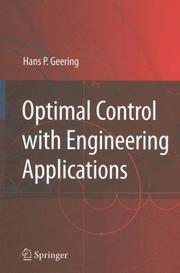
ISBN: 1280817720 9786610817726 3540694382 3540694374 Year: 2007 Publisher: Berlin : Springer,
Abstract | Keywords | Export | Availability | Bookmark
 Loading...
Loading...Choose an application
- Reference Manager
- EndNote
- RefWorks (Direct export to RefWorks)
Because the theoretical part of the book is based on the calculus of variations, the exposition is very transparent and requires mostly a trivial mathematical background. In the case of open-loop optimal control, this leads to Pontryagin’s Minimum Principle and, in the case of closed-loop optimal control, to the Hamilton-Jacobi-Bellman theory which exploits the principle of optimality. Many optimal control problems are solved completely in the body of the text. Furthermore, all of the exercise problems which appear at the ends of the chapters are sketched in the appendix. The book also covers some material that is not usually found in optimal control text books, namely, optimal control problems with non-scalar-valued performance criteria (with applications to optimal filtering) and Lukes’ method of approximatively-optimal control design. Furthermore, a short introduction to differential game theory is given. This leads to the Nash-Pontryagin Minimax Principle and to the Hamilton-Jacobi-Nash theory. The reason for including this topic lies in the important connection between the differential game theory and the H-control theory for the design of robust controllers.
Engineering. --- System theory. --- Computational intelligence. --- Control engineering. --- Robotics. --- Mechatronics. --- Control. --- Computational Intelligence. --- Systems Theory, Control. --- Control, Robotics, Mechatronics. --- Mechanical engineering --- Microelectronics --- Microelectromechanical systems --- Automation --- Machine theory --- Control engineering --- Control equipment --- Control theory --- Engineering instruments --- Programmable controllers --- Intelligence, Computational --- Artificial intelligence --- Soft computing --- Systems, Theory of --- Systems science --- Science --- Construction --- Industrial arts --- Technology --- Philosophy --- Control theory. --- Machine theory. --- Abstract automata --- Abstract machines --- Automata --- Mathematical machine theory --- Algorithms --- Logic, Symbolic and mathematical --- Recursive functions --- Robotics --- Dynamics --- Control and Systems Theory. --- Systems theory.
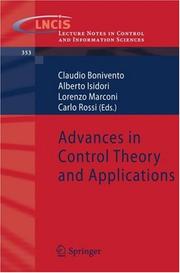
ISBN: 9783540707004 354070700X 9786610940684 1280940689 3540707018 Year: 2007 Publisher: Berlin, Germany ; New York, New York : Springer,
Abstract | Keywords | Export | Availability | Bookmark
 Loading...
Loading...Choose an application
- Reference Manager
- EndNote
- RefWorks (Direct export to RefWorks)
Control theory --- Automatic control --- Intelligent control systems --- Théorie de la commande --- Commande automatique --- Commande intelligente --- Congresses. --- Congrès --- Automatic control -- Congresses. --- Control theory -- Congresses. --- Electronic books. -- local. --- Intelligent control systems -- Congresses. --- Civil & Environmental Engineering --- Engineering & Applied Sciences --- Operations Research --- Engineering. --- System theory. --- Control engineering. --- Robotics. --- Mechatronics. --- Control. --- Control, Robotics, Mechatronics. --- Systems Theory, Control. --- Control and Systems Theory. --- Systems, Theory of --- Systems science --- Science --- Philosophy --- Systems theory. --- Mechanical engineering --- Microelectronics --- Microelectromechanical systems --- Automation --- Machine theory --- Control engineering --- Control equipment --- Engineering instruments --- Programmable controllers
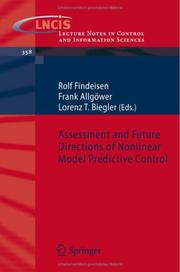
ISBN: 9783540726982 3540726985 3540726993 Year: 2007 Publisher: Berlin, Germany ; New York, New York : Springer,
Abstract | Keywords | Export | Availability | Bookmark
 Loading...
Loading...Choose an application
- Reference Manager
- EndNote
- RefWorks (Direct export to RefWorks)
Thepastthree decadeshaveseenrapiddevelopmentin the areaofmodelpred- tive control with respect to both theoretical and application aspects. Over these 30 years, model predictive control for linear systems has been widely applied, especially in the area of process control. However, today’s applications often require driving the process over a wide region and close to the boundaries of - erability, while satisfying constraints and achieving near-optimal performance. Consequently, the application of linear control methods does not always lead to satisfactory performance, and here nonlinear methods must be employed. This is one of the reasons why nonlinear model predictive control (NMPC) has - joyed signi?cant attention over the past years,with a number of recent advances on both the theoretical and application frontier. Additionally, the widespread availability and steadily increasing power of today’s computers, as well as the development of specially tailored numerical solution methods for NMPC, bring thepracticalapplicabilityofNMPCwithinreachevenforveryfastsystems.This has led to a series of new, exciting developments, along with new challenges in the area of NMPC.
Predictive control --- Nonlinear control theory --- Commande non linéaire --- Congresses. --- Congrès --- Mechanical Engineering - General --- Mechanical Engineering --- Engineering & Applied Sciences --- Model based predictive control --- Model predictive control --- Engineering. --- System theory. --- Control engineering. --- Robotics. --- Mechatronics. --- Control, Robotics, Mechatronics. --- Systems Theory, Control. --- Automatic control --- Systems, Theory of --- Systems science --- Science --- Philosophy --- Systems theory. --- Mechanical engineering --- Microelectronics --- Microelectromechanical systems --- Automation --- Machine theory --- Control engineering --- Control equipment --- Control theory --- Engineering instruments --- Programmable controllers
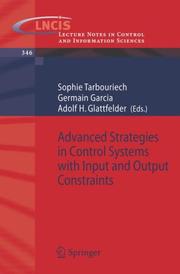
ISBN: 9783540370093 3540370099 9786610955565 1280955562 3540370102 Year: 2007 Volume: 346 Publisher: Berlin, Germany ; New York, New York : Springer,
Abstract | Keywords | Export | Availability | Bookmark
 Loading...
Loading...Choose an application
- Reference Manager
- EndNote
- RefWorks (Direct export to RefWorks)
Physical, safety or technological constraints induce that the control actuators can neither provide unlimited amplitude signals nor unlimited speed of reaction. The control problems of combat aircraft prototypes and satellite launchers offer interesting examples of the difficulties due to these major constraints. Neglecting actuator saturations on both amplitude and dynamics can be source of undesirable or even catastrophic behavior for the closed-loop system (such as loosing closed-loop stability). Such actuator saturations have also been blamed as one of several unfortunate mishaps leading to the 1986 Chernobyl nuclear power plant disaster. For these reasons, the study of the control problem (its structure, performance and stability analysis) for systems subject to both amplitude and rate actuator or sensor saturations as typical constraints has received the attention of many researchers in the last years. The different techniques described throughout the book are particularly attractive for industrial applications not only in aeronautical or space domains but also in the context of biological systems domain. Such methods are well suited for the development of tools that help engineers to solve analysis and synthesis problems in the context of control systems with input and output constraints.
Input-output-modellen. --- Controlesystemen. --- Automatic control --- Control theory --- Commande automatique --- Théorie de la commande --- Automatic control. --- Control theory. --- Electronic books. -- local. --- Mechanical Engineering --- Engineering & Applied Sciences --- Mechanical Engineering - General --- Control engineering --- Control equipment --- Engineering. --- System theory. --- Control engineering. --- Robotics. --- Mechatronics. --- Control, Robotics, Mechatronics. --- Systems Theory, Control. --- Dynamics --- Machine theory --- Engineering instruments --- Automation --- Programmable controllers --- Systems theory. --- Systems, Theory of --- Systems science --- Science --- Philosophy --- Mechanical engineering --- Microelectronics --- Microelectromechanical systems
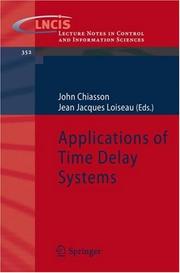
ISBN: 9783540495550 354049555X 9786610853007 128085300X 3540495568 Year: 2007 Volume: v. 352 Publisher: Berlin, Germany ; London, England : Springer,
Abstract | Keywords | Export | Availability | Bookmark
 Loading...
Loading...Choose an application
- Reference Manager
- EndNote
- RefWorks (Direct export to RefWorks)
Time delay systems --- Systèmes à retard --- Automatic control. --- Time delay systems. --- Automatic control --- Mechanical Engineering --- Engineering & Applied Sciences --- Mechanical Engineering - General --- Time delay control --- Time delay control systems --- Time delay controllers --- Time-delayed systems --- Control engineering --- Control equipment --- Engineering. --- System theory. --- Control engineering. --- Robotics. --- Mechatronics. --- Control, Robotics, Mechatronics. --- Systems Theory, Control. --- Feedback control systems --- Process control --- Control theory --- Engineering instruments --- Automation --- Programmable controllers --- Systems theory. --- Systems, Theory of --- Systems science --- Science --- Philosophy --- Mechanical engineering --- Microelectronics --- Microelectromechanical systems --- Machine theory
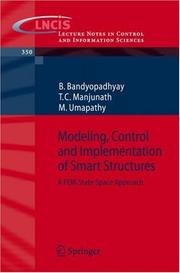
ISBN: 9783540483939 3540483934 9786610853328 1280853328 3540483942 Year: 2007 Volume: v. 350 Publisher: Berlin, Germany ; New York, United States : Springer,
Abstract | Keywords | Export | Availability | Bookmark
 Loading...
Loading...Choose an application
- Reference Manager
- EndNote
- RefWorks (Direct export to RefWorks)
This monograph presents an introductory overview of smart structures, their concepts, their active involvement in the vibration control, their applications and the extensive research work done on it so far. The modelling of flexible beams using two types of beam theories, viz., the Euler-Bernoulli theory and the Timoshenko beam theory is presented, including a new concept of finite element modeling of the flexible structures using Timoshenko beam theory with the inclusion of the shear both in the piezo-patches as well as in the host structure. It presents the design of the periodic output feedback control system for smart structure systems, the design of the FOS controllers for active vibration control and the design of Discrete Sliding Mode controllers using multirate output feedback technique. This monograph is based on the authors work on the multirate output sampling techniques (FOS and POF) and the multirate output feedback based discrete-time sliding mode control of flexible beams with simulations performed in Matlab. The hardware implementation of some of the developed control algorithms is depicted using DSpace and Real Time Workshop.
Smart structures --- Structures intelligentes --- Electronic books. -- local. --- Smart structures. --- Structural control (Engineering). --- Civil Engineering --- Civil & Environmental Engineering --- Engineering & Applied Sciences --- Structural control (Engineering) --- Control of structures (Engineering) --- Adaptive structures --- Intelligent structures --- Engineering. --- System theory. --- Control engineering. --- Robotics. --- Mechatronics. --- Control, Robotics, Mechatronics. --- Systems Theory, Control. --- Structural dynamics --- Systems, Theory of --- Systems science --- Science --- Philosophy --- Systems theory. --- Mechanical engineering --- Microelectronics --- Microelectromechanical systems --- Automation --- Machine theory --- Control engineering --- Control equipment --- Control theory --- Engineering instruments --- Programmable controllers
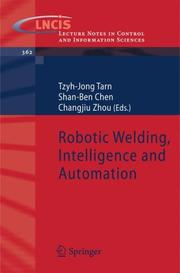
ISBN: 9783540733737 3540733736 9786611066864 1281066869 3540733744 Year: 2007 Volume: 362 Publisher: Berlin, Germany : Springer,
Abstract | Keywords | Export | Availability | Bookmark
 Loading...
Loading...Choose an application
- Reference Manager
- EndNote
- RefWorks (Direct export to RefWorks)
Robotic welding systems have been used in different types of manufacturing. They can provide several benefits in welding applications. The most prominent advantages of robotic welding are precision and productivity. Another benefit is that labor costs can be reduced. Robotic welding also reduces risk by moving the human welder/operator away from hazardous fumes and molten metal close to the welding arc. The robotic welding system usually involves measuring and identifying the component to be welded, we- ing it in position, controlling the welding parameters and documenting the produced welds. However, traditional robotic welding systems rely heavily upon human interv- tion. It does not seem that the traditional robotic welding techniques by themselves can cope well with uncertainties in the welding surroundings and conditions, e. g. variation of weld pool dynamics, fluxion, solid, weld torch, and etc. On the other hand, the advent of intelligent techniques provides us with a powerful tool for solving demanding re- world problems with uncertain and unpredictable environments. Therefore, it is intere- ing to gather current trends and to provide a high quality forum for engineers and researchers working in the filed of intelligent techniques for robotic welding systems. This volume brings together a broad range of invited and contributed papers that describe recent progress in this field.
Welding --- Robots, Industrial --- Robots --- Robots industriels --- Automation --- Congresses --- Control systems --- Congrès --- Systèmes de commande --- Industrial & Management Engineering --- Mechanical Engineering --- Engineering & Applied Sciences --- Engineering. --- System theory. --- Control engineering. --- Robotics. --- Mechatronics. --- Control, Robotics, Mechatronics. --- Systems Theory, Control. --- Forging --- Manufacturing processes --- Metal-work --- Sealing (Technology) --- Systems theory. --- Systems, Theory of --- Systems science --- Science --- Philosophy --- Mechanical engineering --- Microelectronics --- Microelectromechanical systems --- Machine theory --- Control engineering --- Control equipment --- Control theory --- Engineering instruments --- Programmable controllers
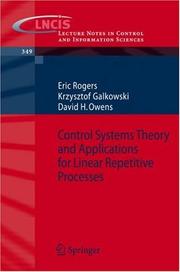
ISSN: 01708643 ISBN: 9783540426639 3540426639 9786610951789 1280951788 3540715371 Year: 2007 Volume: 349 Publisher: Berlin ; Heidelberg : Springer,
Abstract | Keywords | Export | Availability | Bookmark
 Loading...
Loading...Choose an application
- Reference Manager
- EndNote
- RefWorks (Direct export to RefWorks)
After motivating examples, this monograph gives substantial new results on the analysis and control of linear repetitive processes. These include further applications of the abstract model based stability theory which, in particular, shows the critical importance to the dynamics developed of the structure of the initial conditions at the start of each new pass, the development of stability tests and performance bounds in terms of so-called 1D and 2D Lyapunov equations. It presents the development of a major bank of results on the structure and design of control laws, including the case when there is uncertainty in the process model description, together with numerically reliable computational algorithms. Finally, the application of some of these results in the area of iterative learning control is treated --- including experimental results from a chain conveyor system and a gantry robot system.
Linear control systems --- Commande linéaire --- Automatic control. --- Electronic books. -- local. --- Linear control systems. --- Mechanical Engineering - General --- Mechanical Engineering --- Engineering & Applied Sciences --- Control engineering --- Control equipment --- Engineering. --- System theory. --- Complexity, Computational. --- Control engineering. --- Robotics. --- Mechatronics. --- Control. --- Control, Robotics, Mechatronics. --- Complexity. --- Systems Theory, Control. --- Control theory --- Engineering instruments --- Automation --- Programmable controllers --- Automatic control --- Control and Systems Theory. --- Construction --- Industrial arts --- Technology --- Systems, Theory of --- Systems science --- Science --- Philosophy --- Systems theory. --- Computational complexity. --- Complexity, Computational --- Electronic data processing --- Machine theory --- Mechanical engineering --- Microelectronics --- Microelectromechanical systems
| Listing 1 - 10 of 73 | << page >> |
Sort by
|

 Search
Search Feedback
Feedback About UniCat
About UniCat  Help
Help News
News